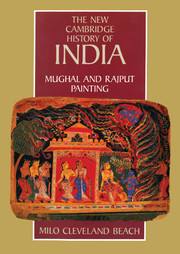Book contents
- Frontmatter
- Introduction
- 1 Painting in North India before 1540
- 2 1540–1580: Painting at Muslim courts
- 3 1580–1600: The new imperial style and its impact
- 4 1600–1660: Mughal painting and the rise of local workshops
- 5 1660–1700: The growth of local styles
- 6 1700–1800: The Dominance of Rajput Painting
- 7 1800–1858: Traditionalism and new influences
- Appendix
- Bibliographical essay
- Index
- The New Cambridge History of India
- References
1 - Painting in North India before 1540
Published online by Cambridge University Press: 28 March 2008
- Frontmatter
- Introduction
- 1 Painting in North India before 1540
- 2 1540–1580: Painting at Muslim courts
- 3 1580–1600: The new imperial style and its impact
- 4 1600–1660: Mughal painting and the rise of local workshops
- 5 1660–1700: The growth of local styles
- 6 1700–1800: The Dominance of Rajput Painting
- 7 1800–1858: Traditionalism and new influences
- Appendix
- Bibliographical essay
- Index
- The New Cambridge History of India
- References
Summary
At the beginning of the sixteenth century, painters in India were already heirs to an unbroken artistic tradition of great antiquity and extraordinary brilliance. Hindu, Buddhist, and Jain religious sanctuaries had long been decorated with carved and painted figures, and these were often accompanied by illustrative wall murals and ornamental designs. The libraries and treasuries of these temples usually housed religious manuscripts; often illustrated and decoratively embellished, these books preserved religious teachings for the use of devotees. As early as the fifth century, the Kama Sutra had mentioned that painting was an established and expected social accomplishment, and contemporary paintings at the Buddhist site of Ajanta are among the most sensuous and sophisticated visual images known from any source (fig. 2). Even today, both unpretentious village houses and royal palaces are decorated with paintings on ceremonial occasions, a longstanding practice, while village storytellers continue to perform in front of narrative scrolls painted in traditional style. Painting, therefore, was never an exclusive or elitist activity, nor one limited to a particular social or religious community.
The majority of the paintings from Ajanta evoke that sense of three-dimensional volume that is so distinctive of Indian sculpture. By the sixteenth century, however, the wall-paintings at such shrine sites as Lepakshi (near Vijayanagar) were instead most expressive through two-dimensional surface design (fig. 3). This was due in part to the relative decline of the sculptural tradition in India, as well as to greater specialization among artists – painters no longer felt obliged to create sculptural effects.
- Type
- Chapter
- Information
- Mughal and Rajput Painting , pp. 4 - 14Publisher: Cambridge University PressPrint publication year: 1992



